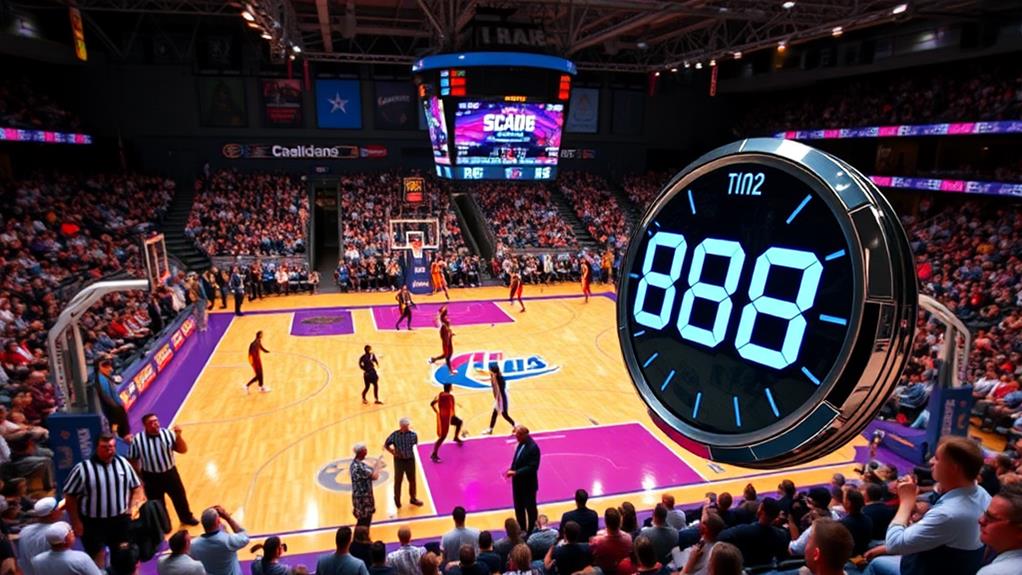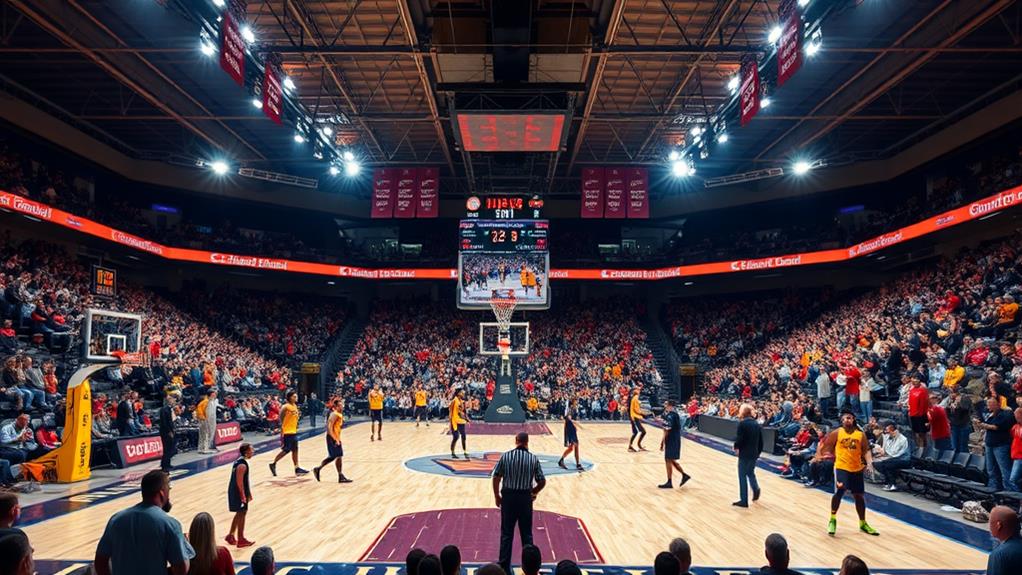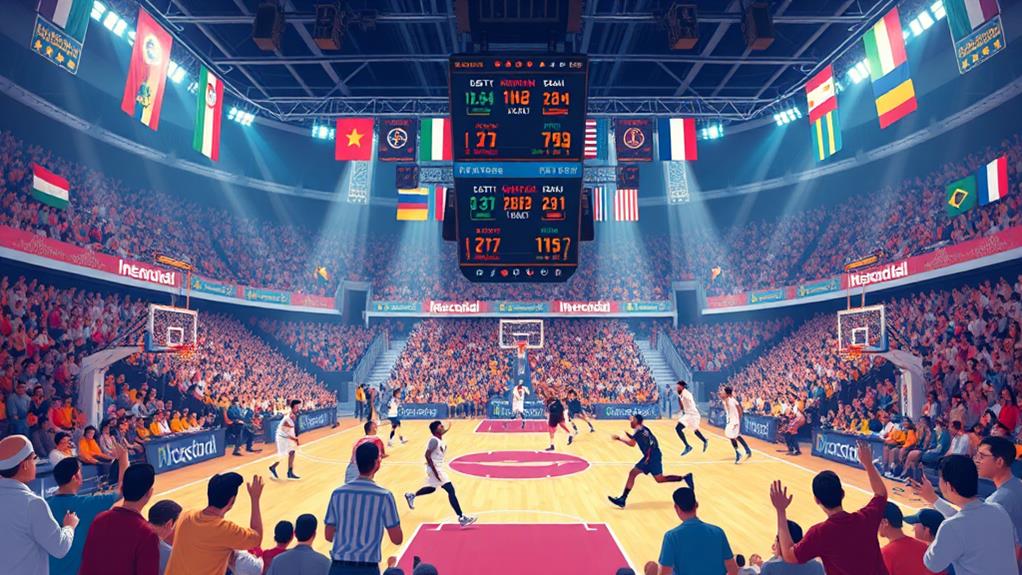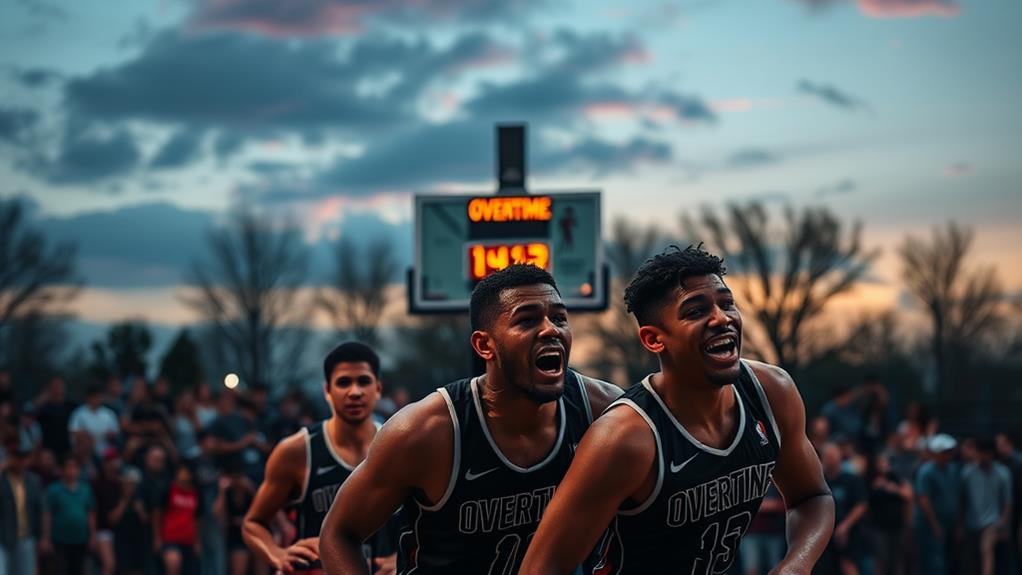
How Long Is a Basketball Game? Everything You Need to Know
November 13, 2024A standard basketball game lasts between 1.5 to 2.5 hours, depending on the league. In the NBA, games consist of four 12-minute quarters, totaling 48 minutes of playtime, while WNBA games have two 20-minute halves for 40 minutes. College men's basketball also runs for 40 minutes, split into two 20-minute halves. International games follow a 40-minute format with four 10-minute quarters. Keep in mind that timeouts, fouls, and overtime can extend the game considerably. If you're curious about specific rules or game variations, there's plenty more to uncover.
Duration of NBA Games
When it comes to the duration of NBA games, you'll find that they're structured into four quarters, each lasting 12 minutes. This totals 48 minutes of actual playtime.
However, the average duration of an NBA game, including stoppages, timeouts, and breaks, is approximately 2.5 hours. For basketball fans, this means you need to set aside a bit more time than just the playtime. Just like in soccer, where stoppage time is essential for fairness, timeouts in basketball play a significant role in managing the game flow.
During the game, each team can call up to seven timeouts, with each timeout lasting 75 seconds. This contributes to the overall game length, as does the 15-minute halftime break. This break allows teams to regroup and strategize for the second half, adding to the anticipation of the game.
If the score is tied at the end of regulation, overtime periods come into play. Each overtime lasts 5 minutes, and there's no limit to how many overtime periods can occur.
WNBA Game Length
When you watch a WNBA game, you're looking at two 20-minute halves, which add up to 40 minutes of action-packed playtime.
The league has seen incredible talent emerge over the years, with players who've left a lasting impact on the sport, similar to the way Bill Russell's record-breaking 11 championships set a standard for excellence.
Plus, there's a halftime break of about 15 minutes and up to four timeouts for each team, giving players a chance to regroup.
If the game ends in a tie, you can expect an additional 5 minutes of overtime to find a winner.
Game Duration Overview
In the WNBA, fans can expect an engaging experience as games are structured into two 20-minute halves, amounting to 40 minutes of on-court action. This effective playtime is complemented by a halftime break lasting approximately 15 minutes, giving you a chance to recharge.
However, the total duration of a WNBA basketball game often exceeds 1.5 hours due to various stoppages. Stoppages can occur for fouls, injuries, and timeouts, with each team allowed up to four timeouts per game. These timeouts can greatly extend the game length, breaking up the flow of play.
If the score remains tied at the end of regulation, the game enters overtime periods, which last 5 minutes each. Multiple overtimes can happen, further prolonging the game duration.
Breaks and Overtime
Throughout a WNBA game, breaks and overtime play an essential role in shaping the overall experience. Each game consists of four quarters, each lasting 10 minutes, giving you 40 minutes of effective playtime.
Between these quarters, you'll find breaks lasting 2-3 minutes, perfect for quick hydration and strategy discussions. Halftime, which lasts about 15 minutes, provides a vital opportunity for teams to regroup and adjust their game plans.
If the score is tied at the end of regulation, the excitement continues into overtime, where each period lasts 5 minutes. There's no limit to the number of overtime periods, which can dramatically extend the game's duration.
With stoppages for fouls, timeouts, and other delays, the average duration of a WNBA game is around 2 hours, similar to the NBA.
These breaks and overtime not only keep players refreshed but also allow coaches to implement effective strategies to secure a win.
College Basketball Timing

College basketball's timing structure can vary greatly between men's and women's games, each offering a unique rhythm to the sport.
In NCAA men's basketball games, you'll find two 20-minute halves totaling 40 minutes of effective playing time. There's a 15-minute halftime break between these halves, allowing teams to regroup.
On the other hand, NCAA women's basketball is divided into four 10-minute quarters, also accumulating 40 minutes of playing time. The halftime break in women's games is shorter, typically lasting 2-3 minutes between the second and third quarters.
Both formats can extend considerably due to stoppages, timeouts, and the potential for overtime periods. If teams remain tied at the end of regulation, a 5-minute overtime period kicks in, with additional overtime periods possible if the tie persists.
Overall, the average duration of a college basketball game, including all stoppages and breaks, typically stretches to about 2 hours and 20 minutes.
Whether you're watching men's or women's college basketball games, you'll experience a dynamic and engaging contest that keeps you on the edge of your seat.
Youth Basketball Formats
When you look at youth basketball formats, you'll notice that game durations can vary greatly. Depending on the league and age group, games are often structured with either shorter quarters or halves to match players' skill levels and attention spans.
This flexibility helps guarantee that the focus remains on developing skills and enjoying the game.
For those interested, soccer moves guide offers insights into similar skill development strategies across sports.
Game Duration Variations
In youth basketball, game durations can vary considerably based on local league rules and the age of the players. Generally, youth basketball games range from 32 to 40 minutes in total duration. Many leagues opt for a game structure that includes four quarters, typically lasting 8 to 10 minutes each. This format allows for structured playtime and necessary breaks.
Some leagues even adopt the NCAA format, featuring two 20-minute halves and a 15-minute halftime break.
Here are some key points about game duration variations in youth basketball:
- Younger age groups often have shorter quarters, usually around 8 minutes.
- The focus is on skill development during these formative years.
- Local league rules heavily influence the chosen game durations.
- Game structures are designed to prepare players for higher-level play.
- Total duration can be adjusted based on the players' needs and league standards.
Understanding these variations in game durations can help you better appreciate the unique aspects of youth basketball games and the importance of creating a supportive environment for developing players.
Age Group Structures
Understanding the different age group structures in youth basketball formats is essential for coaches, players, and parents alike.
In youth basketball, game duration varies considerably based on age groups and local league rules. Most junior levels follow game formats of either four 8-minute quarters or two 20-minute halves, reflecting the NCAA structure. However, younger players often have shorter quarters, with some leagues opting for four 6-minute quarters to match their skill level and stamina.
These varying formats guarantee that games remain engaging and manageable for players, fostering an environment focused on skill development. Breaks during games typically include 2-minute intervals between quarters and a 10-15 minute halftime, giving players time to regroup and strategize.
As you navigate youth basketball, keep in mind that the structure is designed not just for competition but also to prepare players for higher-level play. By understanding these age group formats, you can better support your young athletes in their journey through the sport, assuring they enjoy the game while developing essential skills.
Always check local league rules for specific guidelines, as formats can change based on community regulations.
International Game Durations

International basketball games, governed by FIBA rules, have a structured format that keeps the action moving and fans engaged. Each game consists of four quarters, each lasting 10 minutes, totaling 40 minutes of playtime. This structured approach is vital for global basketball expansion, as it guarantees consistency across major international tournaments.
Between the first and third quarters, there's a 2-minute break, while halftime extends to 15 minutes. If the game is tied at the end of regulation, overtime periods last for 5 minutes.
Here are some key aspects of international game durations:
- Each quarter lasts 10 minutes.
- Total playtime is 40 minutes.
- Overtime periods are 5 minutes long.
- Halftime lasts 15 minutes.
- The average length of an international basketball game is about 2 hours.
This game structure guarantees consistency across major international tournaments, making it easier for fans to know what to expect.
While the actual playtime might seem short, the average length accounts for stoppages, timeouts, and breaks, which contribute to the overall experience.
Factors Affecting Game Length
Basketball games don't have a set length, and several factors can impact how long they last. The game length varies between leagues; for instance, NBA games consist of four 12-minute quarters, totaling 48 minutes, while NCAA games are played in two 20-minute halves, which adds up to 40 minutes.
Overtime periods can also extend game duration markedly, lasting 5 minutes each if teams are tied at the end of regulation time. The introduction of advanced composite materials in basketballs has also influenced the pace of play, as improved grip can lead to quicker and more efficient scoring.
Timeouts are another critical factor. In the NBA, teams can take up to seven timeouts, which can add over 15 minutes to the overall game length. Additionally, stoppages caused by fouls and free throws further affect game duration. The clock stops for fouls, substitutions, and injuries, leading to more interruptions.
Overtime Rules in Basketball

What happens when the score is tied at the end of regulation? In basketball, the game enters overtime, which typically lasts five minutes. This extra duration gives teams a chance to break the tie and secure a victory. Overtime can greatly impact team strategies, as data-driven approaches reveal the importance of effective shot selection during these vital moments data-driven strategies that can lead to a win.
Here are some key overtime rules to keep in mind:
- In the NBA, there's no limit to the number of overtime periods; they keep playing until a winner emerges.
- Each overtime period lasts for five minutes, adding to the game's excitement.
- Teams can use their regular timeouts during overtime, altering their strategies based on the situation.
- The shot clock is set to 14 seconds in overtime, promoting quicker plays and decisions.
- College basketball only allows for one five-minute overtime period if necessary, differing from the NBA's regulations.
Understanding these overtime rules can greatly enhance your appreciation of the game.
Historical Game Length Records
Over the years, basketball has witnessed some astonishing game lengths that showcase the sport's intensity and drama. The longest NBA game, held on January 6, 1951, lasted an incredible 78 minutes after six overtime periods, with the Indianapolis Olympians narrowly defeating the Rochester Royals 75-73. This historical record highlights not just the endurance of the players but also the high-stakes conditions under which they competed, much like the importance of defensive impact and rim protection in shaping game outcomes.
In the WNBA, the longest game took place in June 2002, running for 2 hours and 57 minutes, including three overtime periods. The Orlando Miracle triumphed over the Cleveland Rockers 103-99, further emphasizing how game length can stretch dramatically in vital moments.
NCAA basketball has its own tale of extended gameplay, where a recorded game lasted 70 minutes with multiple overtimes. While the specifics aren't disclosed, it shows that college basketball also grapples with lengthy durations when teams are evenly matched.
These historical records remind you that, in basketball, the duration of the game can greatly exceed standard lengths, making each moment thrilling and unpredictable.
Conclusion
To sum up, understanding the length of a basketball game helps you appreciate the sport more. Did you know that an NBA game typically lasts about 2 to 2.5 hours, including timeouts and halftime? That's plenty of time to enjoy the intense action and strategy on the court. Whether you're watching a youth game or a professional matchup, each format has its own charm, keeping fans engaged and entertained. So grab your snacks and enjoy the game!


